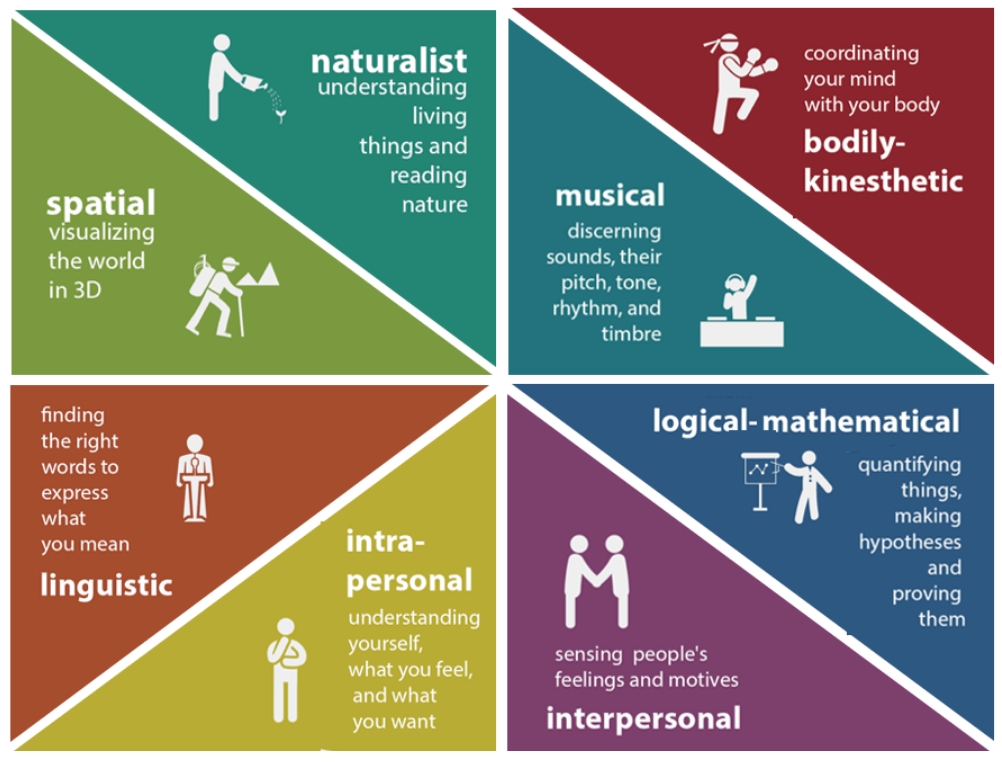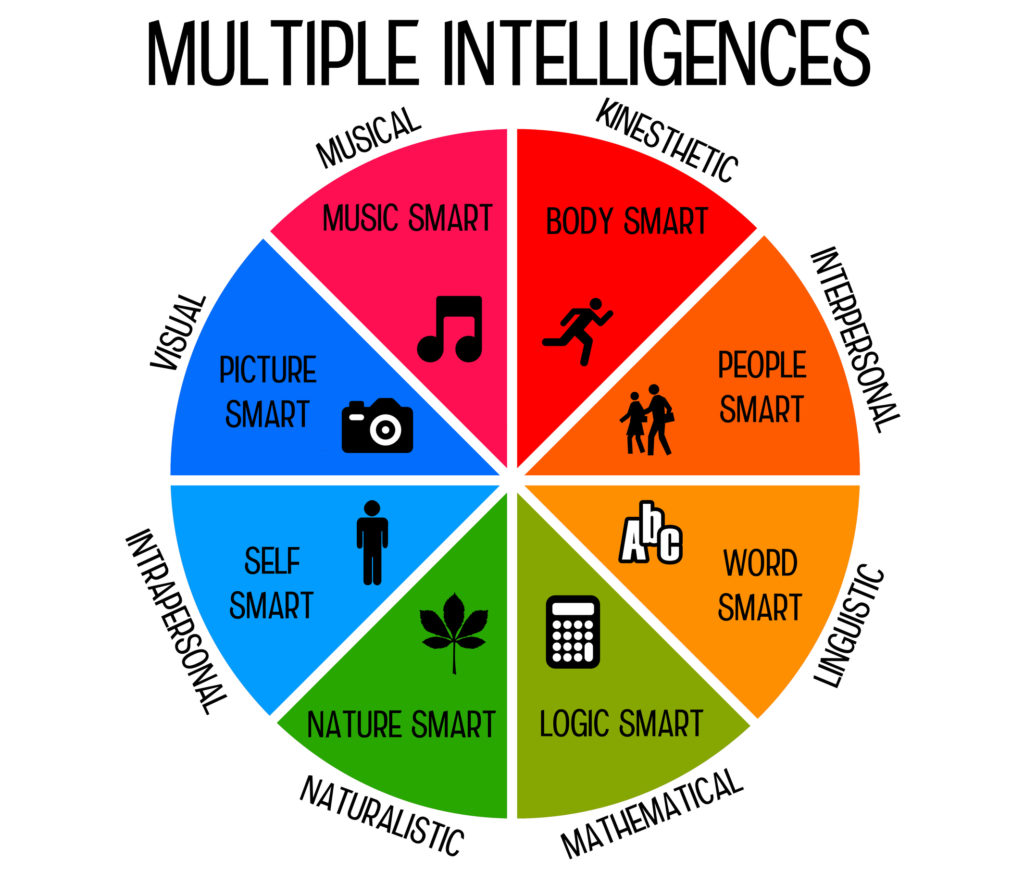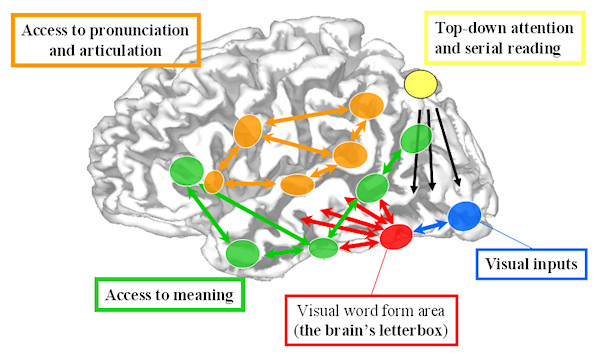What is Multiple Intelligences Theory?
- Howard Gardner’s theory of multiple intelligences proposes that people are not born with all of the intelligence they will ever have.
- This theory challenged the traditional notion that there is one single type of intelligence, sometimes known as “g” for general intelligence, that only focuses on cognitive abilities.
- To broaden this notion of intelligence, Gardner introduced eight different types of intelligences consisting of: Linguistic, Logical/Mathematical, Spatial, Bodily-Kinesthetic, Musical, Interpersonal, Intrapersonal, and Naturalist.
- Gardner notes that the linguistic and logical-mathematical modalities are most typed valued in school and society.
- Gardner also suggests that there may other “candidate” intelligences—such as spiritual intelligence, existential intelligence, and moral intelligence—but does not believe these meet his original inclusion criteria. (Gardner, 2011).
His 1983 book “Frames of Mind”, where he broadens the definition of intelligence and outlines several distinct types of intellectual competencies.
Gardner developed a series of eight inclusion criteria while evaluating each “candidate” intelligence that was based on a variety of scientific disciplines.
He writes that we may all have these intelligences, but our profile of these intelligence may differ individually based on genetics or experience.
Gardner defines intelligence as a “biopsychological potential to process information that can be activated in a cultural setting to solve problems or create products that are of value in a culture” (Gardner, 2000, p.28).
1 Linguistic Intelligence (“word smart”)
Linguistic Intelligence is a part of Howard Gardner’s multiple intelligence theory that deals with sensitivity to the spoken and written language, ability to learn languages, and capacity to use language to accomplish certain goals.
People with linguistic intelligence, such as William Shakespeare and Oprah Winfrey, have an ability to analyze information and create products involving oral and written language such as speeches, books, and memos.
Potential Career Choices
Careers you could dominate with your linguistic intelligence:
Lawyer
Speaker / Host
Author
Journalist
Curator
2 Logical-Mathematical Intelligence (“number/reasoning smart”)
Logical-mathematical intelligence refers to the capacity to analyze problems logically, carry out mathematical operations, and investigate issues scientifically.
People with logical-mathematical intelligence, such as Albert Einstein and Bill Gates, have an ability to develop equations and proofs, make calculations, and solve abstract problems.
Potential Career Choices
Careers you could dominate with your logical-mathematical intelligence:
Mathematician
Accountant
Statistician
Scientist
Computer Analyst
3 Spatial Intelligence (“picture smart”)
Spatial intelligence features the potential to recognize and manipulate the patterns of wide space (those used, for instance, by navigators and pilots) as well as the patterns of more confined areas, such as those of importance to sculptors, surgeons, chess players, graphic artists, or architects.
People with spatial intelligence, such as Frank Lloyd Wright and Amelia Earhart, have an ability to recognize and manipulate large-scale and fine-grained spatial images.
Potential Career Choices
Careers you could dominate with your spatial intelligence:
Pilot
Surgeon
Architect
Graphic Artist
Interior Decorator
4 Bodily-Kinesthetic Intelligence (“body smart”)
Bodily kinesthetic intelligence is the potential of using one’s whole body or parts of the body (like the hand or the mouth) to solve problems or to fashion products.
People with bodily-kinesthetic intelligence, such as Michael Jordan and Simone Biles, have an ability to use one’s own body to create products, perform skills, or solve problems through mind–body union.
Potential Career Choices
Careers you could dominate with your bodily-kinesthetic intelligence:
Dancer
Athlete
Surgeon
Mechanic
Carpenter
Physical Therapist
5 Musical Intelligence (“music smart”)
Musical intelligence refers to the skill in the performance, composition, and appreciation of musical patterns.
People with musical intelligence, such as Beethoven and Ed Sheeran, have an ability to recognize and create musical pitch, rhythm, timbre, and tone.
Potential Career Choices
Careers you could dominate with your musical intelligence:
Singer
Composer
DJ
Musician
6 Interpersonal Intelligence (“people smart”)
Interpersonal intelligence is the capacity to understand the intentions, motivations, and desires of other people and consequently to work effectively with others.
People with interpersonal intelligence, such as Mahatma Gandhi and Mother Teresa, have an ability to recognize and understand other people’s moods, desires, motivations, and intentions.
Potential Career Choices
Careers you could dominate with your interpersonal intelligence:
Teacher
Psychologist
Manager
Salespeople
Public Relations
7 Intrapersonal Intelligence (“self smart”)
Intrapersonal intelligence is the capacity to understand oneself, to have an effective working model of oneself-including own’s desires, fears, and capacities—and to use such information effectively in regulating one’s own life.
People with intrapersonal intelligence, such as Aristotle and Maya Angelou, have an ability to recognize and understand his or her own moods, desires, motivations, and intentions.
This type of intelligence can help a person to understand which life goals are important and how to achieve them.
Potential Career Choices
Careers you could dominate with your intrapersonal intelligence:
Therapist
Psychologist
Counselor
Entrepreneur
Clergy
8 Naturalist intelligence (“nature smart”)
Naturalistic intelligence involves expertise in the recognition and classification of the numerous species—the flora and fauna—of his or her environment.
People with naturalistic intelligence, such as Charles Darwin and Jane Goddall, have an ability to identify and distinguish among different types of plants, animals, and weather formations that are found in the natural world.
Potential Career Choices
Careers you could dominate with your naturalist intelligence:
Botanist
Biologist
Astronomer
Meteorologist
Geologist
Critical Evaluation
Most of the resistance to multiple intelligences theory has come from cognitive psychologists and psychometricians. Cognitive psychologists such as Waterhouse (2006) claimed that there is no empirical evidence to the validity of the theory of multiple intelligences.
Psychometricians, or psychologists involved in testing, argue that intelligence tests support the concept for a single general intelligence, “g”, rather than the eight distinct competencies (Gottfredson, 2004). Other researches argue these Gardner’s intelligences come second or third to the “g” factor (Visser, Ashton, & Vernon, 2006).
Some responses to this criticism include that the Multiple Intelligences theory doesn’t dispute the existence of the “g” factor; it proposes that it is equal along with the other intelligences. Many critics overlook the inclusion criteria set forth by Gardner.
These criteria are strongly supported by empirical evidence in psychology, biology, neuroscience, among others. Gardner admits that traditional psychologists were valid is criticizing the lack of operational definitions for the intelligences, that is, to figure out how to measure and test the various competencies (Davis et al., 2011).
Gardner was surprised to find that Multiple Intelligences theory has been used most widely in educational contexts. He developed this theory to challenge academic psychologists, and therefore did not present many educational suggestions. For this reason, teachers and educators were able to take the theory and apply it as they saw fit.
As it gained popularity in this field, Gardner has maintained that practitioners should determine the theory’s best use in classrooms. He has often declined opportunities to aid in curriculum development that uses multiple intelligences theory, opting to only provide feedback at most (Gardner, 2011).
Most of the criticism has come from those removed from the classroom, such as journalists and academics. Educators are not typically tied to the same standard of evidence and are less concerned with abstract inconsistencies, which has given them the freedom to apply it with their students and let the results speak for itself (Armstrong, 2019).
Implications for Learning
The most important educational implications from the theory of multiple intelligences can be summed up through individuation and pluralization. Individuation posits that because each person differs from other another there is no logical reason to teach and assess students identically.
Individualized education has typically been reserved for the wealthy and others who could afford to hire tutors to address individual students’ needs.
Technology has now made it possible for more people to access a variety of teachings and assessments depending on their needs. Pluralization, the idea that topics and skills should be taught in more than one way, activates individual’s multiple intelligences.
Presenting a variety of activities and approaches to learning helps reach all students and encourages them to be able to think about the subjects from various perspectives, deepening their knowledge of that topic (Gardner, 2011b).
A common misconception about the theory of multiple intelligences is that it is synonymous with learning styles. Gardner states that learning styles refer to the way an individual is most comfortable approaching a range of tasks and materials.
Multiple intelligences theory states that everyone has all eight intelligences at varying degrees of proficiency and an individual’s learning style is unrelated to the areas in which they are the most intelligent.
For example, someone with linguistic intelligence may not necessarily learn best through writing and reading. Classifying students by their learning styles or intelligences alone may limit their potential for learning.
Research shows that students are more engaged and learn best when they are given various ways to demonstrate their knowledge and skills, which also helps teachers more accurately assess student learning (Darling-Hammond, 2010).
About the Author
Michele Marenus is a research assistant at the Ecological Approaches to Social and Emotional Learning (EASEL) Lab at the Harvard Graduate School of Education. She received her master’s from Harvard in 2019 in Human Development and Psychology and she will be starting her doctorate at the University of Michigan.
How to reference this article:
Marenus, M. (2020, June 09). Gardner’s theory of multiple intelligencesy. Simply Psychology. https://www.simplypsychology.org/multiple-intelligences.html
APA Style References
Armstrong, T. (2009). Multiple intelligences in the classroom. Ascd.Darling-Hammond, L. (2010). Performance Counts: Assessment Systems That Support High-Quality Learning. Council of Chief State School Officers.
Edutopia. (2013, March 8). Multiple Intelligences: What Does the Research Say? https://www.edutopia.org/multiple-intelligences-research
Gardner, H. E. (2000). Intelligence reframed: Multiple intelligences for the 21st century. Hachette UK.Gardner, H. (2011a). Frames of mind: The theory of multiple intelligences. Hachette Uk.
Gardner, H. (2011b). The theory of multiple intelligences: As psychology, as education, as social science. Address delivered at José Cela University on October, 29, 2011.Gottfredson, L. S. (2004). Schools and the g factor. The Wilson Quarterly (1976-), 28(3), 35-45.Visser, B. A., Ashton, M. C., & Vernon, P. A. (2006). Beyond g: Putting multiple intelligences theory to the test. Intelligence, 34(5), 487-502.Waterhouse, L. (2006). Inadequate evidence for multiple intelligences, Mozart effect, and emotional intelligence theories. Educational psychologist, 41(4), 247-255.




